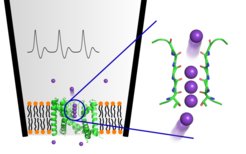Electrophysiology in atomic resolution
The patch clamp technique has revolutionized electrophysiological research and is applied in laboratories worldwide to date. It allows scientists to precisely measure the ion current through a single ion channel. However, it is not possible to observe what happens inside a channel. A research team led by Bert de Groot has now applied molecular dynamics simulations to visualize how potassium ions pass through a potassium ion channel at atomic resolution for the first time. The calculations used were precisely consistent with the patch clamp measurements. The simulations could help to better understand how ion channels are regulated or how potential drugs act on them.
Researchers precisely calculated the electric current flowing through an ion channel for the first time using molecular dynamics simulations and visualized how potassium ions pass through a potassium channel.
Up to four potassium ions line up like pearls on a string as they pass through the potassium channel, contrary to the previous postulation that they are separated by water molecules.
The arrangement of the ions is the basis for both the efficient flow of ions through the channel and its strict selectivity for potassium.

They are literally channels for communication: Pore-forming proteins in living cells, termed ion channels, are embedded in the outer membrane of almost all cell types and play a crucial role in the body’s various communication systems. Blood, immune, and liver cells communicate via these channels. Nerve cells use them to transmit electrical signals to other cells.
Göttingen researchers Erwin Neher and Bert Sakmann developed the patch clamp technique in 1976 at the former Max Planck Institute (MPI) for Biophysical Chemistry (today: MPI for Multidisciplinary Sciences). Their method made it possible, for the first time, to measure the extremely weak electrical current passing through a single open ion channel in a nerve cell. Neher and Sakmann were awarded the Nobel Prize in Physiology or Medicine for their discovery in 1991.
Experimental measurement simulated atom by atom
Patch clamp measurements are very accurate. However, they do not provide detailed information about how ions pass through a channel, how they interact with other ions and molecules, or what makes ion channels so efficient and selective for a particular type of ion. “Molecular dynamics simulations can mimic the experimental setup atom by atom and thus provide insights into processes that we cannot observe experimentally,” explains Bert de Groot, research group leader at the MPI for Multidisciplinary Sciences. The simulations must be verified by comparing them with the ion currents measured using patch clamp technology. Previous simulations fell short in this respect: They did not exactly match the currents measured experimentally.
Almost 50 years after the patch clamp method was developed, de Groot's team, in collaboration with researchers at Queen Mary University London (UK), succeeded in precisely calculating the currents through ion channels that agreed exactly with patch clamp experiments. Using atomistic molecular dynamics simulations that took into account effective electronic polarization, the research team was able to significantly improve the accuracy of these calculations.
Basis for selectivity
With these improved calculations, the researchers realistically depicted how potassium ions pass through a potassium channel while other ions are denied access. Until now, exactly how the ions pass through the channel has been a matter of debate. While earlier data suggested that the individual potassium ions are separated by water molecules in the channel, the latest findings from de Groot's team indicate that up to four potassium ions line up like pearls on a string as they pass through the potassium channel. “This is surprising because the ions should actually repel each other due to their positive charge,” explains Chenggong Hui, first author of the study which has now been published in the scientific journal PNAS. ”This highly unusual arrangement is the basis for both the efficient ion flow and the strict selectivity of the ion channel for potassium. It also prevents smaller ions such as sodium from passing through the channel,” says Hui.
Since ion channels are important targets for drugs, understanding their function is highly relevant for pharmaceutical research. (cr)











